
Mission San Luis Obispo de Tolosa is a Spanish mission founded September 1, 1772 by Father Junípero Serra in San Luis Obispo, California. The mission was named after San Luis, obispo de Talosa.
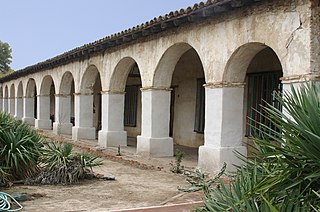
Mission San Miguel Arcángel is a Spanish mission in San Miguel, California. It was established on July 25, 1797, by the Franciscan order, on a site chosen specifically due to the large number of Salinan Indians that inhabited the area, whom the Spanish priests wanted to evangelize.
Rancho Santa Margarita was a 17,735-acre (71.77 km2) Mexican land grant in the Santa Lucia Mountains, in present day San Luis Obispo County, central California.
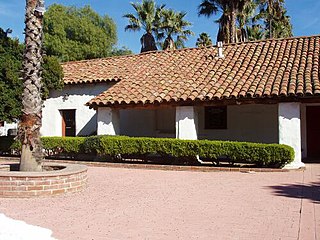
The San Antonio de Pala Asistencia, or the "Pala Mission", was founded on June 13, 1816, as an asistencia or "sub-mission" to Mission San Luis Rey de Francia, some twenty miles inland upstream from the latter mission on the San Luis Rey River. Pala Mission was part of the Spanish missions, asistencias, and estancias system in Las Californias—Alta California. Today it is located in the Pala Indian Reservation located in northern San Diego County, with the official name of Mission San Antonio de Pala. It is the only historic mission facility still serving a Mission Indian tribe.
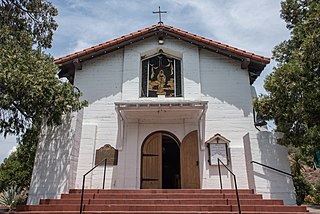
The Santa Ysabel Asistencia was founded on September 20, 1818, at Cañada de Santa Ysabel in the mountains east of San Diego, as a asistencia or "sub-mission" to Mission San Diego de Alcalá, and to serve as a rest stop for those travelling between San Diego and Sonora. The native population of approximately 450 neophytes consisted of both Luiseño and Diegueño peoples. Based on historical records, Santa Ysabel enjoyed a higher-than-average conversion rate when compared to the other California missions. Given its remote location, the facility was visited infrequently by the padres after secularization of the missions in the 1830s.

The Las Flores Estancia was established in 1823 as an estancia ("station"). It was part of the Spanish missions, asistencias, and estancias system in Las Californias—Alta California. Las Flores Estancia was situated approximately halfway between Mission San Luis Rey de Francia and Mission San Juan Capistrano. It is located near Bell Canyon on the Camp Pendleton Marine Corps Base ten miles south of the City of San Clemente in northern San Diego County, California. The estancia is also home to the architecturally significant National Historic Landmark Las Flores Adobe, completed in 1868.

The San Bernardino de Sena Estancia was a ranch outpost of Mission San Gabriel Arcángel in what is now Redlands, California, United States. It was built to graze cattle, and for Indian reductions of the Serrano people and Cahuilla people into Mission Indians. Over time, it fell into disrepair, until the early 20th century, when a new, larger structure was built as a museum. The new structure shares the same architectural style, but is not otherwise similar to the original buildings.

Andrés Pico was a Californio who became a successful rancher, fought in the contested Battle of San Pascual during the Mexican–American War, and negotiated promises of post-war protections for Californios in the 1847 Treaty of Cahuenga. After California became one of the United States, Pico was elected to the state Assembly and Senate. He was appointed as the commanding brigadier general of the state militia during the U.S. Civil War.
Santa Margarita, Spanish for Saint Margaret, may refer to:

Santa Margarita is a unincorporated community located in San Luis Obispo County, California. It was founded in 1889 near Cuesta Peak and San Luis Obispo along State Route 58. The town's name comes from the Mexican Alta California land grant of Rancho Santa Margarita. It is home to the Santa Margarita de Cortona Asistencia site. For statistical purposes, the United States Census Bureau has defined Santa Margarita as a census-designated place (CDP). The population was 1,259 at the 2010 census.
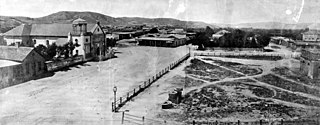
El Pueblo de Nuestra Señora la Reina de los Ángeles del Río de Porciúncula, shortened to Pueblo de los Ángeles, was the Spanish civilian pueblo settled in 1781, which became the American metropolis of Los Angeles. The pueblo was built using labor from the adjacent village of Yaanga and was totally dependent on local Indigenous labor for its survival.

The Sánchez Adobe Park, home to the Sánchez Adobe, is located in Pacifica, California, at 1000 Linda Mar Boulevard, on the north bank of San Pedro Creek, approximately 0.91 miles (1,470 m) from the Pacific Ocean in Linda Mar Valley. The 5.46-acre (2.21 ha) county park, established in 1947 contains the Sanchez Adobe Historical site, designated a National Register Historical District in 1976 and is California registered landmark 391.

La Iglesia de Nuestra Señora la Reina de los Ángeles is a historic Catholic church in Los Angeles, California, located on the historic Plaza de Los Ángeles near Downtown Los Angeles. Part of the larger El Pueblo de los Ángeles Historical Monument, the church's origins date to 1784, when the Spanish founded the Nuestra Señora Reina de los Ángeles Asistencia to support nearby Mission San Gabriel Arcángel. By 1814, the asistencia had been abandoned and a new church was founded in its place by Padre Luis Gil y Taboada. The church is one of the oldest buildings in Los Angeles.
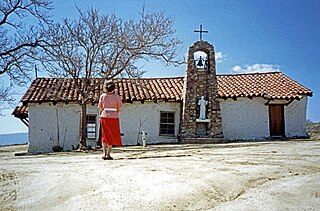
Warner Springs is set of springs and a small unincorporated community in northern San Diego County, California. It is on the Pacific Crest Trail.
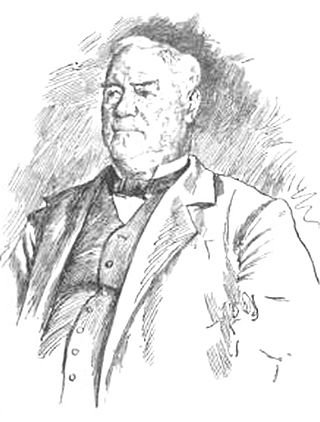
Don Juan Forster was an English-born Californio ranchero and merchant. Born in England, he emigrated to Mexico at age 16 and became a Mexican citizen. Soon after, he moved to California, where he married into the prominent Pico family of California and eventually held vast rancho grants across Southern California.
Rancho Asuncion was a 39,225-acre (158.74 km2) Mexican land grant in present-day San Luis Obispo County, California. It was given in 1845 by Governor Pío Pico to Pedro Estrada. The grant extended along the Salinas River in the Santa Lucia Range, and encompassed present-day Atascadero. Originally, Rancho de le Asuncion was part of the Mission San Miguel Arcángel territory and as such, was part of the Salinan Indian tribal territory.

The Mexican Secularization Act of 1833, officially called the Decree for the Secularization of the Missions of California, was an act passed by the Congress of the Union of the First Mexican Republic which secularized the Californian missions. The act nationalized the missions, transferring their ownership from the Franciscan Order of the Catholic Church to the Mexican authorities.
Rancho San Juan Capistrano del Camote, translated as, Camote is probably an error in the documents, Camote would be Camate, which referred to the stream that ran through the grant and that in the 19th century was called the Camate according to Walter Murray [1858], or Comatti according to Annie L. Morrison [1917], now called Camatta Creek. The Rancho was a 44,284-acre Mexican land grant in the San Juan Valley, 13.7 miles southeast of Shandon, California in present-day San Luis Obispo County, California.
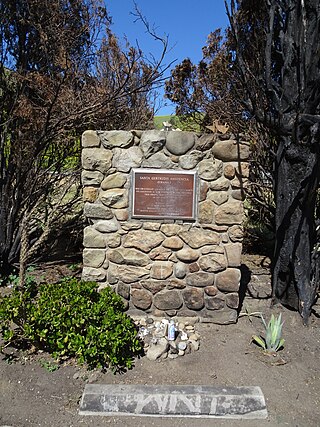
The Santa Gertrudis Asistencia, also known as the Santa Gertrudis Chapel, was an asistencia ("sub-mission") to the Mission San Buenaventura, part of the system of Spanish missions in Las Californias—Alta California. Built at an unknown date between 1792 and 1809, it was located approximately five miles from the main mission, inland and upstream along the Ventura River. The site was buried in 1968 by the construction of California State Route 33. Prior to the freeway's construction, archaeologists excavated and studied the site. A number of foundation stones were moved and used to create the Santa Gertrudis Asistencia Monument which was designated in 1970 as Ventura County Historic Landmark No. 11.

















